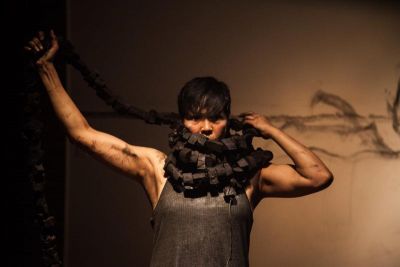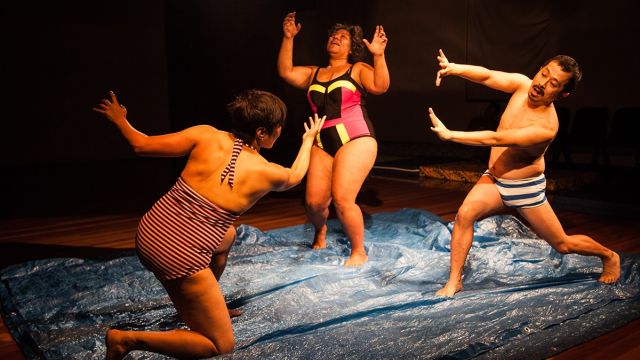Disaffected
This performance aims to raise awareness of the disastrous effect of climate change on the island nations of the Pacific – who we are urged to see as just that, a nation of islands linked by common heritage. Activist and performer Latai Taumoepeau prefers to think of them as “Oceania: a sea of islands with no borders that were forged apart by colonisation” and are experiencing the worst effects of climate change, though they have contributed least to it. The performance therefore aspires to bring about a cultural and spiritual transformation in attitudes – and, one would hope, inspire relevant action.
Director Kym Vercoe: “Disaffected asks us to contemplate a global challenge. It’s big, it’s dirty and it’s difficult. How messy it gets is up to us”.
However, if one hadn’t heard a panel discussion about this prior to the performance, or were among those already converted to the cause, it might be a little difficult for those who deny climate change (like two of our supposedly intelligent senior politicians who lampooned the predicament of island nations in an overheard aside) to get those messages.
The performance was devised over four years with funding from Blacktown Arts Centre, Arts NSW and The Arts Council, and is based on interviews with local people who have relatives and friends facing losing their homes in Oceania and becoming “displaced persons”. It is based in contemporary dance and dramatic movement and backed by discordant sounds (Tom Hogan) and dim lighting (Amber Silk).
 As such, it is essentially esoteric in nature and almost episodic in style. Each segment is symbolic of an aspect of environmental change. Each segment is stretched to an intense level. And though recorded voices recount personal accounts or news broadcasts of disasters such as typhoons and drought and cyclones, the audience is expected to translate the symbolism.
As such, it is essentially esoteric in nature and almost episodic in style. Each segment is symbolic of an aspect of environmental change. Each segment is stretched to an intense level. And though recorded voices recount personal accounts or news broadcasts of disasters such as typhoons and drought and cyclones, the audience is expected to translate the symbolism.
This is fine for aficionados of contemporary dance, or those who are close to the stories and the performers – but is it not the ‘deny-ers’ and the apathetic that the performance aims to move to action? If so, it needs more of a sledgehammer than a feather duster to make an impression.
Don’t get me wrong, the performers – Valerie Berry, Ryuichi Fujimura and Latai Taumoepeau – are talented and have a wealth of experience. All three work incredibly hard in strenuous and moving segments that require enormous physical and emotional control. The symbols they use are environmentally suggestive … blue plastic tarpaulins representing the sea, sheets of corrugated iron representing the destructive havoc of a typhoon, shell money, a plastic wine bladder, chunks of coal … and the choreography in which they are used is inventive and effective, albeit very slow.
Sitting on mattresses and cushions (and some chairs) around the perimeter of the space, the audience feels the discomfort of the themes and the tight control of the performers – but once again, it is esoteric. There is no real call to action. There are no suggestions of what that action could … should … must … be taken.
Carol Wimmer
Subscribe to our E-Newsletter, buy our latest print edition or find a Performing Arts book at Book Nook.

